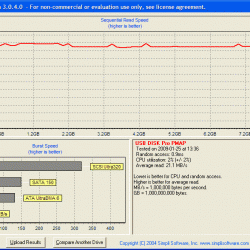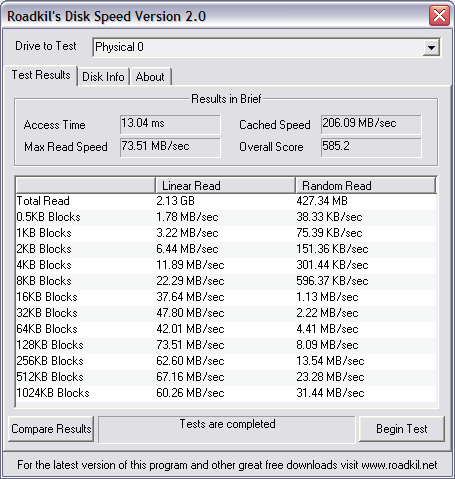Performance Checking… Do it BEFORE you configure eBoostr!
Just to give everybody some ideas about what “performance” you might see from your systems BEFORE you implement eBootr — knowing this information will help you decide where to put your cache file(s) or whether having eBoostr will even benefit or hinder you.
Of course, system RAM is always THE best place to put cached information, but not all of us wish to give up a huge chunk of System RAM all the time (other programs might need it, e.g. Photoshop). So, I’ve run some testing on my own system to provide you with samples. I have a USB flash drive (not the best, but large capacity for my own purposes), an onboard Intel RAID controller (RAID 1 – Mirroring), and a GIGABYTE i-RAM SATA-I drive with 4GB of DDR. Here are the results using HDTACH. In my case, the [2nd] BEST place for the cache file is on the i-RAM disk (along with my pagefile, Temporary Internet Files, and system TEMP folder), where #1 would be system RAM of course.
Rankings of performance:
#1: System RAM
#2: i-RAM Disk
#3: Intel RAID 1
#4: USB Flash Drive



Jan 26, 2009
Hello,
“along with my pagefile”
1 question : how do you include your pagefile as priority application in eBoostr?
Thanks in advance
Jan 26, 2009
Hello Emile,
eBoostr does not include the pagefile in caching. The i-Ram device is actually a SATA-connected DDR RAM-based disk which shows up as a drive. I have configured Windows to use this drive for the paging file, which significantly reduced overhead on my system drive.
I’ve had the i-RAM for some time now, so I wouldn’t actually recommend it to anyone for performance boosting anymore. The reason is because Solid-State Disk (SSD) technology is affordable now and the newest consumer SSDs are reaching 250 MB/s read/write transfer rates with seek times of less than .05 ms. Along with the ever-increasing storage capacities (versus the i-RAM’s limited 4 GB maximum), SSDs have now become the premium choice for I/O performance gain (I/O is the biggest bottleneck in most PCs).
Windows boots to the Desktop in a matter of *seconds* with these SSDs, and a 16GB drive is plenty for most desktop installations. However, even SanDisk is getting seriously into this game with models coming out mid-year which are high-capacity (128GB+) at a very good price ($2/GB).
Sorry to say, but it’s only a matter of months before software like eBoostr or ReadyBoost is not needed anymore!
http://www.gizmag.com/sandisk-announce-worlds-fastest-ssd/10763/
Jan 26, 2009
Hello, William.
Thank you for the detailed test. I just want to note that it is a little bit incomplete. The main reason of the performance increase by eBoostr is that your “random” read speed is greatly increased with using flash memory cache devices. You were only measuring sequental read access speed and surely hard disks are much faster than flash in this case. Due to the fact that flash memory has an almost zero seek times you’ll get a greater speed in “random” reads (that’s the usual system and apps behaviour.)
Here are the screenshots of the tests on my desktop.
Random read speed of my hard disk (just a single SATA disk, no RAIDs):

And here goes my flash pen drive (Kingston DataTraveler 2GB):

As you can see the results are ten times higher for the small files on the flash memory.
That is why eBoostr gives performance increase.
Jan 26, 2009
“Accidently” I have the exact same USB disk (Kingston Data Traveler), and I recently bought a new (cheapo) one because I needed more space : Integral USB Stick 8Gb, a whopping 14€.
I’d upload the tests if only I knew how … =( Anyway, what’s most striking is that my Integral thingie is noticeably slower in Linear and Random read (upto 24Mb/s), but has an access time of “only” 0.78ms and YES it makes things feel faster when using this one with eBoostr vs the Kingstong one, indicating even more so the importance of Access Time over Max Read Speed !
That said, I think William is right in that SSD’s are going to be the next big thing when it comes to performance. However, I’m also pretty sure that it will take quite a while before I’ll consider replacing my current harddisk with an SSD version because
* it still works
* ‘tricks’ like eBoostr make working with it quite ‘tolerable’
* SSD will remain quite expensive for a while IMHO. Yes, their price is coming down, fast, but they’re not even close and as disks are getting bigger every month, but cost more or less the same, SSD still has a long way to catch up.
(ps: my laptop has room for only 1 disk, so I can’t just use a 16Gb SSD for OS & programs and a ‘mechanical’ drive for data etc… )
Jan 26, 2009
Andrey,
Your USB flash drive is not typical of the average consumer. It’s rated at 40MB/s read, not the usual 20MB/s. This is why in previous posts, I have recommended getting these higher-speed USB flash devices in order to see a gain.
Using a typical 20 MB/s thumb drive, there’s not much gain for files above 128K in size. About 25-33% of the files eBoostr seems to cache are over 128K in size. With that averaging out, there is likely not much gain at all if the USB device is not adequate.
I would not recommended using the spindle drive as a cache since that is where static data is stored anyway. Nor would I recommend avoiding eBoostr altogether. I am trying to show folks that they need to determine the best location for the cached data.
Random or sequential reads for solid-state media is, for the most part, irrelevant. Thus, my tests were just fine for this demonstration because it’s safe to assume people are here to use eBoostr with flash memory.
Also, eBoostr must keep a record of cached file locations for future retrieval. This means there’s really no random reads occurring — the data is stored in what I assumed to be a contiguous file, and the cached request is targeted using the location data. So, in this regard, the read is basically sequential.
TTFN!
Jan 26, 2009
Ah, another thing to help others:
Try not to plug your USB flash memory into a HUB or shared USB ports. Plug it into a dedicated USB 2.0 port connected directly to the motherboard.
Two reasons:
1) Other devices can hog the USB line during data transfers or communications.
2) Some devices will force the USB line down to USB 1.0 speeds, even if they’re the only 1.0 device on the chain.
Hope this helps some of you!
Jan 26, 2009
deroby,
Yes, seek (or access) time is important — but there’s a curve based on seek time and bandwidth (max speed) which cannot be ignored if we want to see maximum benefit.
Jan 26, 2009
this is a really good thread…
since the data improvement is greater on smaller files wouldn’t it be nice to have an option to ignore files over ###KB?
is there a place (if not there should be) where we can see the actual speeds of all those usb flash drives out there?
just to clarify formating your usb flash drives to the smallest available “allocation unit size” is good for random access. correct?
the size of Solid-State Disks is going up but the overall performance levels arn’t. well not yet anyways. compared to the raptor the SSD’s still have to reach much higher through-puts ie: >150MB/s you can still get two raptors in raid-0 for far less with better performance.
and last but not least you could upgrade to the i-ram2 it’s sata 8GB i think.
Jan 26, 2009
add this file mask to the exclude list to ignor files over 1024KB.
size:>1,024KB
other file masks can be taken from the advanced search pane as well.
date:>1/26/2009 from this date on
modified:=1/26/2009 modified today
etc…
Jan 26, 2009
It’s difficult to find a benchmark utility which does all the required tests to affirm results. Anybody know a tool which charts seek time, total access time, and speed, based on block size? I haven’t seen this kind of detail yet — the current tools use calculations unknown to the end-user.
Since looking at the charts above again, and combining some storage theory, flash memory *should* have relatively flatter curves (even for random seeks), but as Andrey has posted above, the numbers appear to get worse the smaller the block size! Reading 512kb blocks at 1/60th the possible maximum speed? Hmmm… it doesn’t make complete sense (especially considering the average access time) unless there is some overhead adding up, such as the access time being applied per IOP rather than per File I/O.
We (everyone) really need to look into finding the best USB-based flash media for eBoostr! I am with simerline860: Suggest we add a section to this site where people can post their benchmarks for their USB flash memory for comparison! But, we still need to find a utility specifically designed to test solid-state media and not try to use older utilities to benchmark with. They do not appear to take into account the physical differences of flash-based memory.